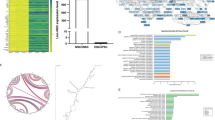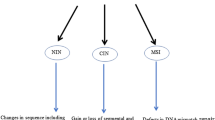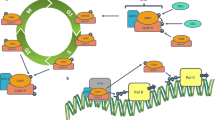Summary
Lidamycin (LDM, also known as C-1027) as an anti-cancer agent inhibits growth in a variety of cancer cells by inducing apoptosis and cell cycle arrest. In this study we demonstrated that inhibition of mouse embryonic carcinoma (EC) cell growth using LDM at low concentrations can be attributed to a loss of the cell’s self-renewal capability but not to apoptosis or cell death, which can be correlated to the down-regulation of embryonic stem (ES) cell-like genes Oct4, Sox2 and c-Myc. MTT assays showed that LDM inhibited the growth of mouse P19 EC cells in a time- and dose-dependent manner. The EC cells exposed to a low dose (0.01 nM) of LDM lost their capability to generate colonies, as evidenced by the colony forming assay. Flow cytometer analyses demonstrated that LDM induced G1 arrest in exposed EC cells without apoptosis. Real-time qPCR, Western blotting and immunocytochemistry revealed that Oct4, Sox2 and c-Myc were down-regulated in LDM-exposed EC cells, but not adriamycin (ADM)-exposed cells. Furthermore, a combination of the low dose of LDM and ADM significantly reduced the proliferation of the cancer cells than single-agent treatment. This suggested that synergy of ADM and LDM improved chemotherapy. Taking together, our results indicate that LDM can reduce the capability for self-renewal that mouse EC cells possess through the repression of ES cell-like genes, thereby inhibiting carcinoma cell growth. This data also suggests that LDM might have potential for application in CSC-based therapy and be a useful tool for studying ES cell pluripotency and differentiation.






Similar content being viewed by others
References
Dalerba P, Cho RW, Clarke MF (2007) Cancer stem cells: models and concepts. Annu Rev Med 58:267–284
Vermeulen L, Sprick MR, Kemper K et al (2008) Cancer stem cells—old concepts, new insights. Cell Death Differ 15:947–958
Reya T, Morrison SJ, Clarke MF, Weissman IL (2001) Stem cells, cancer, and cancer stem cells. Nature 414:105–111
Clarke MF, Dick JE, Dirks PB et al (2006) Cancer stem cells—perspectives on current status and future directions: AACR Workshop on cancer stem cells. Cancer Res 66:9339–9344
Zhou BB, Zhang H, Damelin M et al (2009) Tumor-initiating cells: challenges and opportunities for anticancer drug discovery. Nat Rev Drug Discov 8:806–823
Ben-Porath I, Thomson MW, Carey VJ et al (2008) An embryonic stem cell-like gene expression signature in poorly differentiated aggressive human tumors. Nat Genet 40:499–507
Diehn M, Cho RW, Clarke MF (2009) Therapeutic implications of the cancer stem cell hypothesis. Semin Radiat Oncol 19:78–86
Tai MH, Chang CC, Chang CC et al (2005) Oct4 expression in adult human stem cells: evidence in support of the stem cell theory of carcinogenesis. Carcinogenesis 26:495–502
Trosko JE (2009) Review paper: cancer stem cells and cancer non-stem cells: from adult stem cells or from reprogramming of differentiated somatic cells. Vet Pathol 46:176–193
Webster JD, Yuzbasiyan-Gurkan V, Trosko JE et al (2007) Expression of the embryonic transcription factor Oct4 in canine neoplasms: a potential marker for stem cell subpopulations in neoplasia. Vet Pathol 44:893–900
Ku JL, Shin YK, Kim DW et al (2010) Establishment and characterization of 13 human colorectal carcinoma cell lines: mutations of genes and expressions of drug sensitivity genes and cancer stem cell markers. Carcinogenesis. doi:10.1093/carcin/bgq043
Gao MQ, Choi YP, Kang S et al (2010) CD24 (+) cells from hierarchically organized ovarian cancer are enriched in cancer stem cells. Oncogene. doi:10.1038/onc.2010.35
Nichols J, Zevnik B, Anastassiadis K et al (1998) Formation of pluripotent stem cells in the mammalian embryo depends on the POU transcription factor Oct4. Cell 95:379–391
Hong Y, Winkler C, Liu T et al (2004) Activation of the mouse Oct4 promoter in medaka embryonic stem cells and its use for ablation of spontaneous differentiation. Mech Dev 121:933–943
Boiani M, Scholer HR (2005) Regulatory networks in embryo-derived pluripotent stem cells. Nat Rev Mol Cell Biol 6:872–884
Chew JL, Loh YH, Zhang W et al (2005) Reciprocal transcriptional regulation of Pou5f1 and Sox2 via the Oct4/Sox2 complex in embryonic stem cells. Mol Cell Biol 25:6031–6046
Eilers M, Eisenman RN (2008) Myc’s broad reach. Genes Dev 22:2755–2766
Chen X, Hsu HS, Chen YW et al (2008) Integration of external signaling pathways with the core transcriptional network in embryonic stem cells. Cell 133:1106–1117
Moriguchi H (2009) The reprogramming factors of human somatic cells are novel targets for human hepatocellular carcinoma therapy. Hepatology 50:2046–2047
Hu G, Kim J, Xu Q et al (2009) A genome-wide RNAi screen identifies a new transcriptional module required for self-renewal. Genes Dev 23:837–848
Xu YJ, Zhen YS, Goldberg IH (1994) C1027 chromophore, a potent new enediyne antitumor antibiotic, induces sequence-specific double-strand DNA cleavage. Biochemistry 33:5947–5954
Cai L, Chen H, Miao Q et al (2009) Binding capability of the enediyne-associated apoprotein to human tumors and constitution of a ligand oligopeptide-integrated protein. J Biotechnol 144:142–150
Tanaka T, Fukuda-Ishisaka S, Hirama M, Otani T (2001) Solution structures of C-1027 apoprotein and its complex with the aromatized chromophore. J Mol Biol 309:267–283
Kennedy DR, Beerman TA (2006) The radiomimetic enediyne C-1027 induces unusual DNA damage responses to double-strand breaks. Biochemistry 45:3747–3754
Xu YJ, Li DD, Zhen YS (1990) Mode of action of C-1027, a new macromolecular antitumor antibiotic with highly potent cytotoxicity, on human hepatoma BEL-7402 cells. Cancer Chemother Pharmacol 27:41–46
He QY, Liang YY, Wang DS, Li DD (2002) Characteristics of mitotic cell death induced by enediyne antibiotic lidamycin in human epithelial tumor cells. Int J Oncol 20:261–266
Zhen YZ, Lin YJ, Shang BY, Zhen YS (2009) Enediyne lidamycin induces apoptosis in human multiple myeloma cells through activation of p38 mitogen-activated protein kinase and c-Jun NH2-terminal kinase. Int J Hematol 90:44–51
Takahashi K, Yamanaka S (2006) Induction of pluripotent stem cells from mouse embryonic and adult fibroblast cultures by defined factors. Cell 126:663–676
Chambers I, Smith A (2004) Self-renewal of teratocarcinoma and embryonic stem cells. Oncogene 23:7150–7160
Jho EH, Malbon CC (1997) Galpha12 and Galpha13 mediate differentiation of P19 mouse embryonic carcinoma cells in response to retinoic acid. J Biol Chem 272:24461–24467
Sharif T, Auger C, Bronner C et al (2009) Selective proapoptotic activity of polyphenols from red wine on teratocarcinoma cell, a model of cancer stem-like cell. Invest New Drugs. doi:10.1007/s10637-009-9352-3
Monk M, Holding C (2001) Human embryonic genes re-expressed in cancer cells. Oncogene 20:8085–8091
Huang YH, Shang BY, Zhen YS (2005) Antitumor efficacy of lidamycin on hepatoma and active moiety of its molecule. World J Gastroenterol 11:3980–3984
Diehn M, Cho RW, Lobo NA et al (2009) Association of reactive oxygen species levels and radioresistance in cancer stem cells. Nature 458:780–783
Hu G, Kim J, Xu Q (2009) A genome-wide RNAi screen identifies a new transcriptional module required for self-renewal. Genes Dev 23:837–848
Blelloch RH, Hochedlinger K, Yamada Y et al (2004) Nuclear cloning of embryonic carcinoma cells. Proc Natl Acad Sci USA 101:13985–13990
van der Heyden MA, Defize LH (2003) Twenty one years of P19 cells: what an embryonic carcinoma cell line taught us about cardiomyocyte differentiation. Cardiovasc Res 58:292–302
Wang C, Xia C, Bian W et al (2006) Cell aggregation-induced FGF8 elevation is essential for P19 cell neural differentiation. Mol Biol Cell 17:3075–3084
Song J, Lu YC, Yokoyama K et al (2004) Cyclophilin A is required for retinoic acid-induced neuronal differentiation in p19 cells. J Biol Chem 279:24414–24419
Marikawa Y, Tamashiro DA, Fujita TC, Alarcon VB (2009) Aggregated P19 mouse embryonic carcinoma cells as a simple in vitro model to study the molecular regulations of mesoderm formation and axial elongation morphogenesis. Genesis 47:93–106
Martins-Taylor K, Xu RH (2010) Determinants of pluripotency: from avian, rodents, to primates. J Cell Biochem 109:16–25
Andrews PW, Matin MM, Bahrami AR et al (2005) Embryonic stem (ES) cells and embryonic carcinoma (EC) cells: opposite sides of the same coin. Biochem Soc Trans 33:1526–1530
Takaishi S, Okumura T, Tu S et al (2009) Identification of gastric cancer stem cells using the cell surface marker CD44. Stem Cells 27:1006–1020
Trosko JE (2006) From adult stem cells to cancer stem cells: Oct-4 Gene, cell-cell communication, and hormones during tumor promotion. Ann NY Acad Sci 1089:36–58
Hu T, Liu S, Breiter DR et al (2008) Octamer 4 small interfering RNA results in cancer stem cell-like cell apoptosis. Cancer Res 68:6533–6540
Frank NY, Schatton T, Frank MH (2010) The therapeutic promise of the cancer stem cell concept. J Clin Invest 120:41–50
Korkaya H, Wicha MS (2007) Selective targeting of cancer stem cells: a new concept in cancer therapeutics. BioDrugs 21:299–310
Shi YK, Wu SY, Huang YH, Zhen YS (2006) Chemosensitivity of mdr1 gene overexpressed multidrug resistant cancer cells to lidamycin. Yao Xue Xue Bao 41:1146–1151
Acknowledgements
We would like to thank Yong-Shu Zhen (Professor, Department of Oncology, Institute of Medicinal Biotechnology, Chinese Academy of Medical Science, Beijing, China) for kindly providing us with the anti-cancer drug lidamycin, Hong-Ti Jia (Professor, Department of Molecular and Biochemistry, Peking University Health Science Center) for the discussion of the manuscript, Ling-Song Li (Chairman, Department of Cell Biology, Peking University Health Science Center) for some financial support and the experimental facility, Prof. Tai-Ping Wang for helping to proofread the manuscript and Dr. Chris Capel, Urs. Lienert and Qimin Huang for the final revision. We are gratefully indebted to Lan Yuan and Ji-Hong Liu for technical support for the confocal microscope. This work was also supported by the Foundation of “211 Project” and “985 Project” in P R China.
Author information
Authors and Affiliations
Corresponding authors
Additional information
Hong-Ying Zhen and Qi-Hua He contributed equally to this study.
Electronic supplementary material
Below is the link to the electronic supplementary material.
Fig. 1
Low dose of LDM maintenance of P19 EC cell growth in non-apoptotic status. As described in the Methods section, the cells were exposed to 0.01 nM LDM for the indicated number of hours and collected from the medium and dishes by centrifuge, separately. Apoptosis assay was carried out as Fig. 4a described by flow cytometer (GIF 312 kb)
Rights and permissions
About this article
Cite this article
Zhen, HY., He, QH., Zhen, YZ. et al. Inhibition of mouse embryonic carcinoma cell growth by lidamycin through down-regulation of embryonic stem cell-like genes Oct4, Sox2 and Myc. Invest New Drugs 29, 1188–1197 (2011). https://doi.org/10.1007/s10637-010-9463-x
Received:
Accepted:
Published:
Issue Date:
DOI: https://doi.org/10.1007/s10637-010-9463-x




